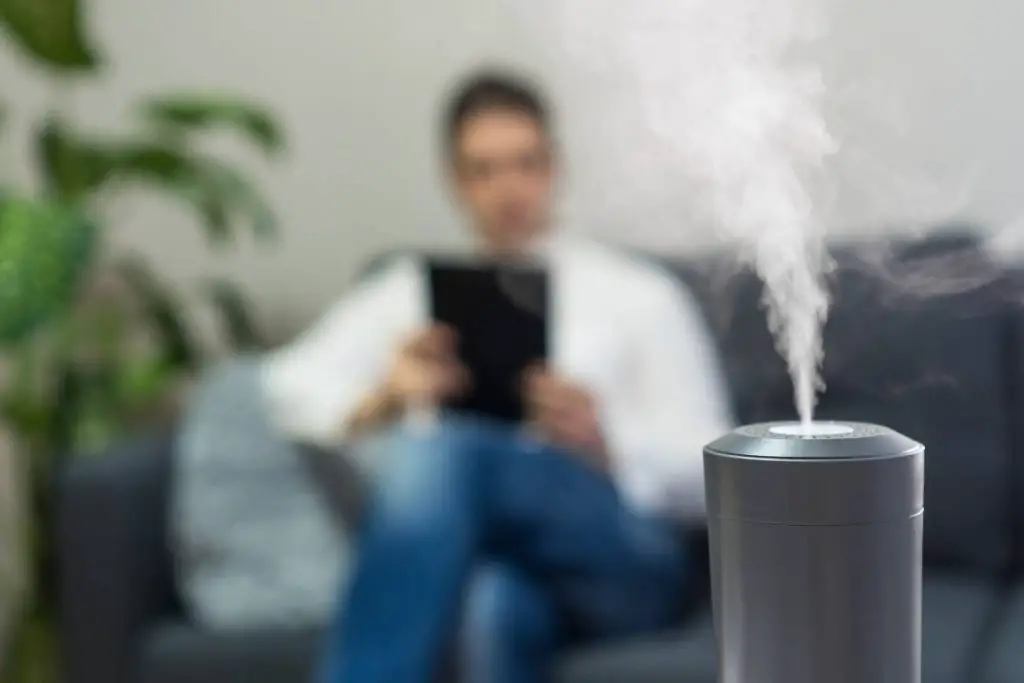If you’ve just finished cleaning your humidifier only to find that it’s now non-operational, it’s easy to get frustrated. Maybe you’re even considering ditching your current humidifier for a new one that works as intended. If your humidifier doesn’t work after cleaning, there are a few things you can try before giving it up.
There are many possible causes for humidifier malfunction, such as insufficient power, improper humidistat levels, mildew build-up in the reservoir, or mechanics. The cause may also depend on the type of humidifier you’re using. Address and amend the issues to ensure it runs as intended.
Humidifiers serve an important—and in some medical cases, critical—purpose, so it’s essential to understand their maintenance and upkeep properly. Read the article for more details on the proper cleaning methods for different types of humidifiers and a few common problems and solutions.

Warm vs. Cool Mist Humidifiers
The first step towards getting your humidifier working again is knowing what type of unit you have. Different types of humidifiers require different cleaning and maintenance practices, so determine what kind of humidifier you have.
There are two main categories of humidifiers on the market: those which rehydrate the air using hot steam and those that do so using cool mist (source). Heated humidifiers produce visible steam, making them easy to differentiate from cool mist humidifiers, which extrude invisible vapor.
Cool mist humidifiers work by channeling air through an internal filter. The filter absorbs water, hydrating the air that’s passed through. A fine, invisible mist is then dispersed into the room. As a rule, cool mist humidifiers are easier to clean and maintain than hot steam humidifiers.
Common Humidifier Problems and Solutions
The constant cycling of water through humidifiers makes them more prone to water damage than other appliances, especially as the water is converted into vapor. You must clean the humidifiers regularly to stay on top of mildew and keep the unit in operational condition.
If your humidifier isn’t functioning right after cleaning it, there are a few possibilities for causes and solutions. The key to fixing your humidifier is starting off with an accurate understanding of the problem. Start by isolating the nonfunctional component of the humidifier.
What To Do if Your Humidifier Won’t Turn On
If you’ve finished cleaning your humidifier and find that it won’t turn, the first thing to check is the power source. Ensure that the humidifier is plugged in and that the wall outlet is functional. If necessary, test the outlet using an appliance you know is functional, or check using a voltage tester if one is available.
Humidifiers need to be unplugged during cleaning, so be sure the unit is reconnected once everything is clean and dry. If the power source isn’t the source of the issue, proceed down the checklist until you find the origin of the symptom.
What To Do if Your Humidifier Doesn’t Produce Mist
If the humidifier will power on but will not produce mist, try checking the humidistat, which is the humidifier component that dictates when the humidifier comes on and turns off. It works essentially like a thermostat, comparing the user’s desired setting against the humidity of the room.
After a thorough cleaning, the humidistat may take several hours to adjust and reacclimate to the room’s humidity. If the humidifier will turn on but isn’t producing mist after a clean, give the humidistat time to recalibrate before deciding that there’s something wrong with the unit.
If the issue isn’t the humidistat, double-check that the tank has been refilled after the cleaning is complete. Cleaning a humidifier requires the tank to be emptied of water. If the humidifier is inexplicably refusing to produce mist, the solution may be a simple matter of refilling the tank.
What To Do if Your Humidifier Is Not Increasing the Humidity
If the humidifier appears to be running properly, but the room’s humidity remains unaffected, there may be an issue with the evaporation pads. Check the pads, cleaning or replacing them as required. If the issue isn’t with the evaporation pads, double-check the humidistat.
What To Do if the Humidifier Is Running Loud
As with any piece of machinery, a louder than average idle volume is typically a sign that there’s something wrong. If the humidifier is running too loud, check the fan motors.
The fan motors are generally the loudest component of the humidifier and are most likely to be responsible for extraneous noise pollution.
What To Do if Your Humidifier Is Leaking
If the humidifier is leaking, there are a number of possible causes. Humidifier leaks can be caused by a backup of water in the line. If this is the case, the solution is to eliminate the slopes from the drain line and flush the system with water.
Another possible cause of leaks can be the directional valve. If the water flow is set in the wrong direction, it can result in a regular leak.
If an open valve is the cause of the leak, the solution is to shut off the power and shut the valve right away. Valves can become stuck in an open position if the water is highly calcified or if debris becomes lodged in the valve. Shut the valve and flush with water if this is the case.
High water pressure can also cause humidifiers to leak. Any water pressure level higher than 125 pounds per square inch (861845 Pascal) can cause leaks. This issue can be resolved by checking the water pressure regularly and implementing a pressure reducer whenever the water pressure rises above the 125 psi limit (source).
What To Do if Your Humidifier Produces Foul Odors After Cleaning
If you’re noticing a bad smell coming from the humidifier after you’ve cleaned it, chances are there’s mold or mildew somewhere in the unit.
Due to the high levels of moisture that naturally occur in a humidifier, these units are more prone to mold and mildew.
If your humidifier is producing foul odors, you may have to clean it all over again to get rid of any mold. Follow these steps:
- Unplug the unit and take it completely apart.
- Clean the base and water tank using undiluted white vinegar.
- Pour the vinegar into the tank, ensuring that it comes into contact with every surface of the tank.
- Before you dump out the vinegar, allow roughly 20 minutes to sit in the tank.
- Once the vinegar has had sufficient time to eat away at any mildew or bacteria growing on the tank’s surface, empty out the solution.
- Scrub the emptied tank with an old toothbrush or similar instrument. This will remove any remaining mildew or calcium deposits left by the humidifier water. Small parts can be detailed cleaned using a brush or rag dipped into undiluted white vinegar.
- Once all the parts have been cleaned, flush them with water.
- Allow the parts to air dry before reassembling the humidifier.
Do Not Wash Wick Filters
If your humidifier dispenses cool mist, it probably operates using an internal wick filter. When cleaning the humidifier, don’t attempt to clean the filter. Washing the filter is likely to damage the antimicrobial coating, as well as the material of the filter itself.
If it appears that the filter is the source of the odor, it’s more effective to purchase a new one. To ensure you’re purchasing the right replacement wick filter for your brand and humidifier model, use Amazon’s “confirmed fit” feature.
You can check out this Vornado Humidifier Replacement Wicks (link to Amazon). These genuine Vornado disposable wicks are made from high-quality materials, and they can absorb a lot of water while filtering out the air.
How To Deep Clean a Humidifier
If you’ve cleaned your humidifier following the instructions listed above and you’re still noticing a bad scent, you may have to deep clean the unit.
According to Good Housekeeping, deep cleaning a humidifier is accomplished by disinfecting each component with a diluted bleach or peroxide solution.
The cleaning solution should be 1 gallon (3.78 L) of water mixed with 1 teaspoon (0.16 fl oz) of chlorine bleach. Some humidifiers recommend using hydrogen peroxide rather than bleach. If using hydrogen peroxide, the solution should be 3% peroxide to 97% water.
Once you have the right cleaning solution, follow these steps:
- Mix the cleaning solution in the water tank.
- When the solution is thoroughly mixed, situate the tank back on the unit, allowing the cleaning solution to drain into the water reservoir.
- Once that’s done, allow the solution roughly 20 minutes to disinfect the surfaces.
- After you’ve allowed the solution time to work, empty out and flush the system with water.
- Rinse continually until the tank no longer smells of bleach.
Check or Reset the Humidistat
The humidistat, sometimes referred to as a hygrostat, is a device that monitors the humidity of a certain area. In humidifiers, it’s responsible for dictating at what humidity level the humidifier turns on.
After you’ve cleaned and reassembled your humidifier, you may have to check or reset the humidistat. If the humidistat is set at a level lower than that of the room, the humidifier won’t come on. The recommended humidity level for residential living is between 45%-60%.
Troubleshooting a Whole House Humidifier
Unlike portable humidifiers, which can be broken down and cleaned easily, a whole-house humidifier system is typically too large and complex to be repaired by amateurs.
If you’re having trouble with your whole-house humidifier, however, there are a few things you can do to solve the issue before you turn it over to the professionals.
- Shut off the power supply.
- Shut off the water supply to the humidifier.
- Remove the cover from the whole-house humidifier system.
- Take out the drum and inspect the pad. If there is mineral build-up on the foam pad, it must be either cleaned or replaced.
- Return the water supply.
- Give the reservoir time to refill before returning the cover to its position.
- Restore the power supply.
Source: American Standard Air
Why It’s Important To Repair and Maintain Humidifiers
The air around us is laden with water in the form of humidity at all times. The amount of water in the air is measured in percent values known as relative humidity.
Humidity has an effect on the health and well-being of those breathing and living in the air. High humidity can be uncomfortable during the warm months, while low humidity tends to increase the dry, frigid sensations of the cold season.
Depending on where you live and the time of year, the addition of either warm or cool mist humidifiers can help balance out the natural extremes that come with the seasons. Humidifiers are also extremely beneficial to those suffering or recovering from respiratory illness.
If you use a humidifier regularly to modulate the humidity of your living space, it’s important to ensure that it’s properly cleaned and maintained. If mold or calcium deposits are allowed to form as a result of neglected upkeep, the air will be saturated with foul odors, among other issues.
Failure to clean calcium and debris from valves can also result in leaks, damaging the furniture or flooring around the humidifier.
Final Thoughts
If you’ve just cleaned your humidifier and it’s not working right away, that doesn’t mean that unit is broken. Before deciding that it’s time to buy a new humidifier, try disassembling and deep cleaning each component again, allowing it to fully dry before putting it back together.
Depending on the kind of humidifier you have, the process of cleaning may vary. In some cases, it may be necessary to purchase a replacement part in order to avoid purchasing an entirely new humidifier.
Declutter your home once and for all (Even if you have no time and don't know where to begin)! Learn More.

